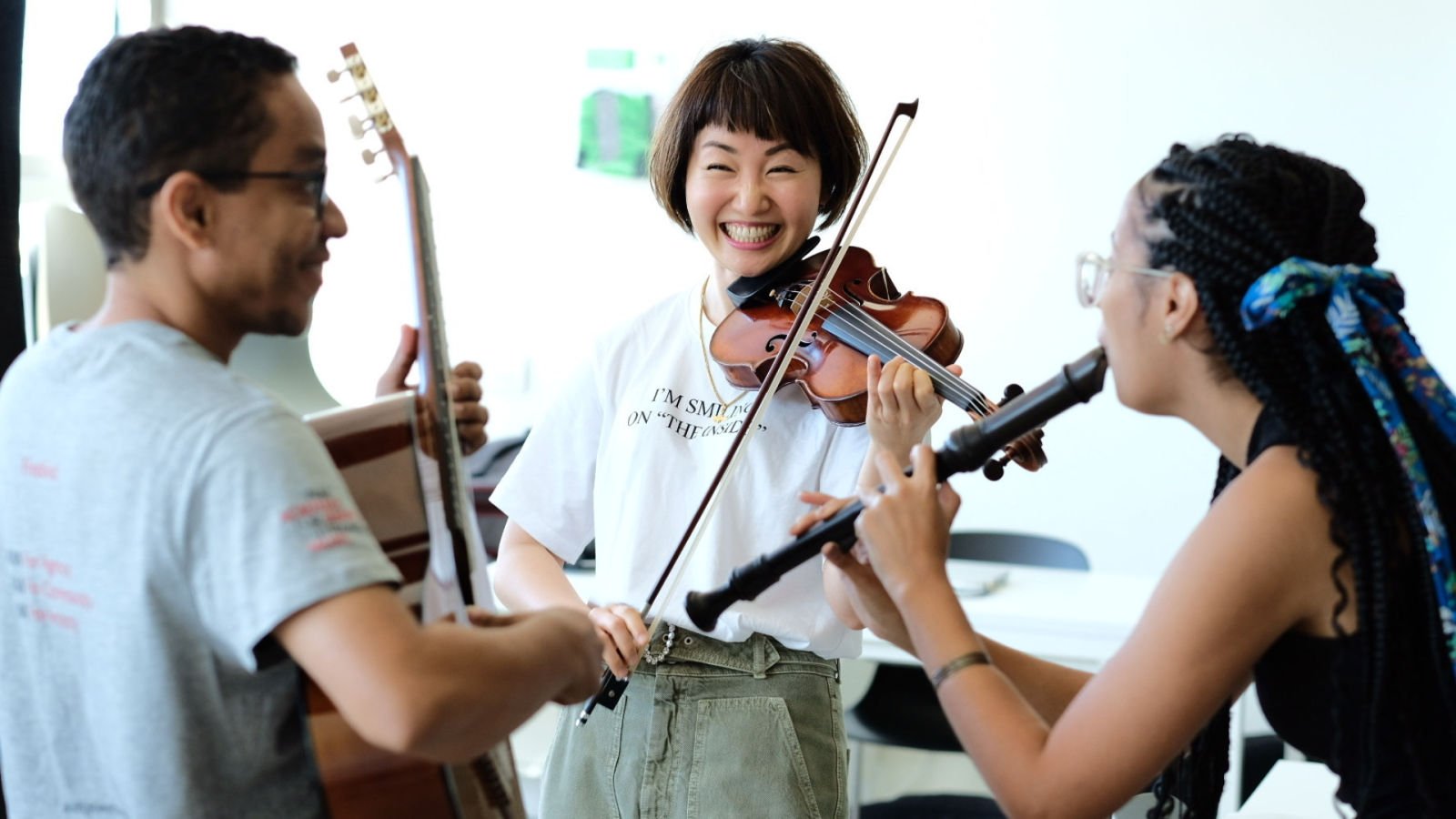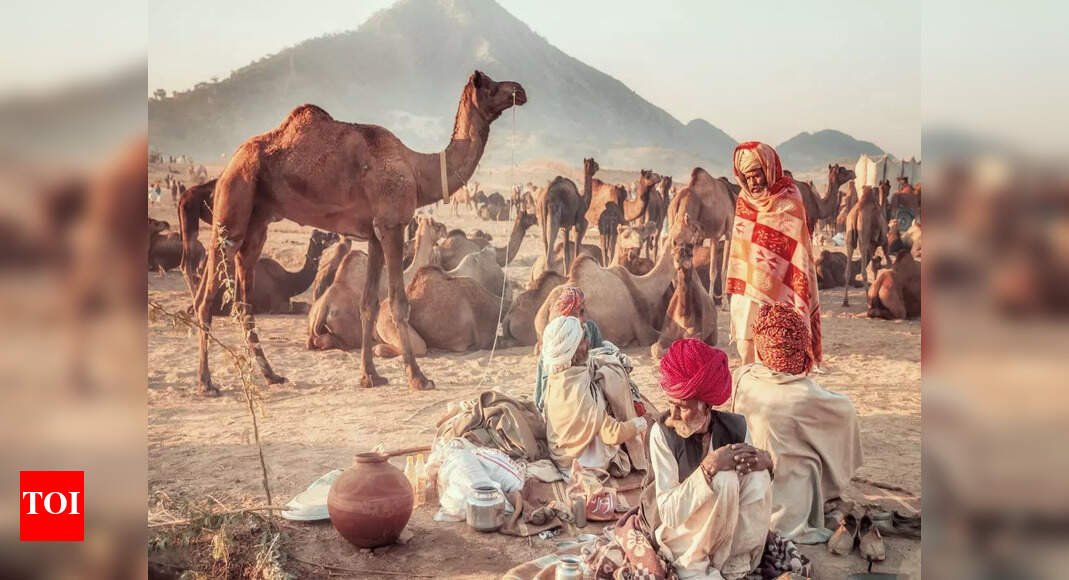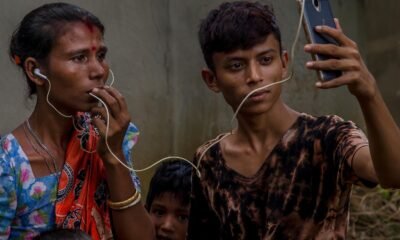Travel Guides & Articles
How Violinist Mika Nishimura Is Elevating Music Education In India

Violinist and educator Mika Nishimura, trained at prestigious institutions like the Franz Liszt Academy and the Jacobs School of Music, has spent over a decade in India reimagining music education. While her foundation lies in the rigour of Western classical training, her work with Mumbai-based NGO Muktangan shifted her focus towards collaborative, human-centred learning. This journey inspired Elevate, a multidisciplinary camp she co-founded with educator Katheryn Murillo, blending music, movement, nutrition, and mentorship to nurture confident, empathetic young leaders. She talks to Travel + Leisure India & South Asia about her vision of helping children connect across divides and believe in their own voice—on stage, in classrooms, and in life.
Excerpts From The Interview With Mika Nishimura
Team T+L India: The camp blends music, movement, nutrition, and leadership. Why did you choose this multidisciplinary approach?
Mika Nishimura: My journey as a music educator began with a strong foundation in Western classical music—trained in world-class institutions like the Franz Liszt Academy, Reina Sofia School, and the Jacobs School of Music. Most of my early experience was shaped through traditional one-on-one lessons and teacher-led group classes. While I deeply value this background, I began to feel a growing desire to create something more collaborative and human-centred.
That shift began when I started working with Muktangan, a progressive NGO in Mumbai. There, I met children from incredibly diverse backgrounds—many facing deep challenges but filled with resilience and potential. We began rethinking how music was taught. Instead of focusing only on technique, we moved towards group learning, peer support, and shared leadership. I witnessed something powerful: students started leading each other.
This transformation became the seed for Elevate—a camp designed not just to teach music, but to nurture young leaders who are grounded, expressive, and empathetic. But as we developed the camp, it became clear: in India, leadership development must go hand-in-hand with basic wellbeing. Many children, even of the same age, come with drastically different levels of energy, focus, and physical readiness—often due to lack of nutrition or opportunities for movement.
That’s why Elevate goes beyond music. It includes movement to energise the body, nutrition education to build strength and awareness, and mentorship to nurture inner confidence. Without proper nutrition, children don’t have the strength to move.
Team T+L India: What is the most rewarding part about teaching music and leadership to children from diverse backgrounds?
Mika Nishimura: This is the beauty and the strength of India—its diversity. But when I first came here over 10 years ago and brought children from different backgrounds together for a music class, some refused to even share a music stand. That moment stayed with me. I truly believe music can connect people across any divide.
To me, leadership begins with empathy. To lead, you must understand and care about others—not as categories, but as human beings. Music, movement, and food are universal. We all eat. We all hum in the shower. We all move to a rhythm. These shared human experiences help children see beyond difference. This is how we shape a new kind of leader—and a better future.
But we’ve also witnessed how many children, simply because of the circumstances they were born into—their families, their neighbourhoods—are destined for a certain path, or sometimes not even to attend school. Seeing these injustices made us realise we needed to act to help change that reality.
Team T+L India: In what ways does your Japanese heritage influence the way you approach teaching and creating music in India?
Mika Nishimura: These days, people often joke that I’m more Indian than Japanese—and maybe they’re right! But my Japanese roots will always give me a love for precision and attention to detail…sometimes so much that it irritates my students (we laugh about it together!). That care for the small things helps me design learning experiences with thoughtfulness and structure.
At the same time, I’ve fallen in love with the energy of Indian children. They ask questions freely, they aren’t shy to say, “I don’t understand, please explain again,” and they bring so much curiosity into the room.
Over the years, I think I’ve absorbed some of that energy myself! I’m also the loudest voice in the classroom, full of love and passion. This mix of Japanese discipline and Indian vibrancy allows me to create learning spaces with structure, but also with freedom born from the soul—where children feel safe to express themselves fully, in their own way.
Team T+L India: Which elements from Indian culture have influenced your own creative expression since moving here?
Mika Nishimura:Since moving here, I’ve been deeply impressed by how beautiful Indian music and culture truly are. At the same time, I love how open and creative people are—ready to collaborate, explore, and welcome influences from anywhere in the world, whether it’s fashion, art, or ideas. In music, that openness gives you the freedom to play in your own way, without feeling pressured to be the same as everyone else. Indian people genuinely appreciate individuality. That’s the beauty of this country—they accept you for who you are, and they also celebrate the uniqueness I bring from Japan. When these two cultures meet, something even more unique and beautiful is born.
Team T+L India: Can you share a moment during the camp preparations that truly moved you?
Mika Nishimura: One of my students once told me, “Thank you, Mika. After learning the violin with you, I no longer need maths tuition.” She had been at the bottom of her class in maths—but after practising music, she began understanding how to scaffold problems and think logically. Now, she’s at the top of her class.
That’s when I realised: everything is connected. The way athletes, musicians, and leaders train their minds—it’s all about focus, reflection, and structure. Nutrition, too, is not a separate topic. It’s the energy source. Without it, how can a child learn or move?
Team T+L India: How has travel-from Japan to Spain, Israel, and India-influenced your perspective on cultural fusion in the arts?
Mika Nishimura: Travelling with my violin has taught me that “home” can be anywhere. When I arrived in a new country, I didn’t always speak the language—but the moment I started to play, people would smile, listen, and connect. That’s when I understood: music creates its own home.
Whether it was playing in a quiet corner in Europe, rehearsing with strangers who became friends in the Middle East, or sharing songs with children in India, each place has left a mark on my soul. These moments showed me that cultural fusion isn’t just in the arts—it’s in the way people open their hearts to each other when we create together.
Team T+L India: Thinking ahead, how do you envision expanding initiatives like this in other Asian cities, and what impact do you hope to create through music education in the region?
Mika Nishimura: This is just the beginning. Even before our first Elevate camp finishes, we’ve already received offers from other countries to collaborate on future editions. We’ve started planning the next chapter, and our vision is to keep Elevate growing—not just in size, but in depth and reach.
We’d love to collaborate with more schools and organisations across Mumbai and beyond. If you believe in the power of music, movement, nutrition, and mentorship to shape future leaders, we’re here. Let’s keep growing this community together.
Related: Unearthing India’s Oldest Musical Roots In Gwalior, The City Of Tansen
Note:
The information in this article is accurate as of the date of publication.
We may earn an affiliate commission when you shop through links on our site.
Written By
Travel Guides & Articles
Which Is The Top Credit Card With Best Offers, Like Free Airport Lounges, Rewards And Travel Benefits? News24 –

India is seeing a steady rise in credit card usage, with banks rolling out new offers and features to attract fresh customers and persuade existing cardholders to switch. There are numerous websites and apps where customers can compare benefits, including the number of free airport lounges and travel offers, to choose the best credit card tailored to their needs. Here, we give you insight to the best credit cards that offer the most at lower fees. You can compare the benefits and choose the one. Is HDFC Regalia Gold the best?
HDFC Regalia Gold Credit Card
The HDFC Regalia Gold Credit Card is one of the most sought-after premium credit cards in India, offering a strong combination of rewards, travel perks, and lifetime benefits. However, it faces competition from several other cards that challenge its position in the market. This article examines the HDFC Regalia Gold alongside its top three competitors: SBI Card PRIME, ICICI Bank Sapphiro, and Axis Bank SELECT.
HDFC Regalia Gold Credit Card
Annual Fees and Charges
- The card has an initial and annual fee of ₹2,500 plus GST.
- The renewal fee is waived if the cardholder spends ₹4 lakh or more in a calendar year.
- The foreign currency markup is 2%, making it suitable for international transactions.
Rewards
- For every ₹150 spent on retail purchases, the cardholder earns 4 reward points.
- Purchases at partner merchants like Nykaa, Myntra, Marks & Spencer, and Reliance Digital earn 5 times the rewards (20 points per ₹150).
Airport Lounges And Other Benefits
- ₹2,500 gift voucher to the new cardholders
- ₹1 lakh spending in the initial 90 days of card issuance
- Free Swiggy One and MMT Black Elite membership
- 12 domestic airport lounge visits each year
- 6 international lounge visits via the Priority Pass membership
- ₹1,500 worth of vouchers on spending ₹1.5 lakh per quarter
- ₹5,000 worth of flight vouchers on 5 lakh spending
- Additional ₹5,000 flight vouchers on 7.5 lakh
- The card comes with full insurance coverage
- ₹1 crore air accident cover with purchase protection
- No liability for a lost card if it is reported immediately
Axis Bank SELECT
The Axis Bank SELECT card is designed for people who spend on retail. It offers high benefits for shopping and dining.
Annual Fees and Charges
- Joining fee of ₹3,000 and an equal annual fee.
- Free for Burgundy customers.
- Renewal fee is waived if annual spending reaches ₹8 lakh.
- Foreign currency markup is 3.5%.
Rewards
- Cardholders earn 10 EDGE points for every ₹200 spent.
- They earn 20 EDGE points for every ₹200 spent on retail purchases, up to ₹20,000 per month.
- Each EDGE point has a redemption value of approximately ₹0.20.
Airport Lounges And Other Benefits
- The card offers 12 international lounge visits per year through Priority Pass membership
- It also provides 2 domestic lounge visits per quarter
- Lounge access is subject to a minimum quarterly spend of ₹50,000
- New cardholders will earn 10,000 EDGE points of 2,000 in the first transaction
- The card offers 6 free golf rounds per year.
- It provides a 1% waiver on fuel surcharge for purchases between ₹400 and ₹4,000.
- Cardholders receive dining discounts through the Axis Dining Delights program.
SBI Card PRIME
Premium lifestyle credit card offering extensive travel and dining perks.
Annual Fees and Charges
- Joining fee: ₹2,999 + GST.
- Annual fee: ₹2,999 + GST (waived if annual spending reaches ₹3 lakh).
- Foreign currency markup: 3.5%.
Rewards
- Earn 2 reward points for every ₹100 spent on regular purchases.
- Earn 10 reward points for every ₹100 spent on dining, groceries, departmental stores, and movies.
- On birthdays, earn 20 reward points for every ₹100 spent.
Airport Lounges And Other Benefits
- 8 domestic lounge visits per year (2 per quarter).
- 4 international lounge visits via Priority Pass membership.
- 1% fuel surcharge waiver, up to ₹250 per month.
- 50% discount on golf games.
- 25% discount on dining through the American Express Dining Platform.
ICICI Bank Sapphiro
The ICICI Bank Sapphiro targets high spenders on travel and lifestyle.
Annual Fees and Charges:
- Joining fee: ₹6,500 + GST.
- Annual fee: ₹3,500 + GST.
- Renewal fee is waived for annual spending of ₹6 lakh.
- Foreign currency markup: 3.5%.
Rewards
- Earn 2 reward points for every ₹100 spent on domestic transactions.
- Earn 4 reward points for every ₹100 spent on international transactions.
- Milestone program: earn 4,000 points on ₹4 lakh annual spending.
- Earn 2,000 points for every additional ₹1 lakh spent after that.
Airport Lounges And Other Benefits
- 16 domestic lounge visits per year.
- 2 international lounge visits per year.
- Domestic lounge access is generous, but international access is limited.
- Welcome benefits: ₹13,000 worth of shopping and travel vouchers for new cardholders.
- Additional benefits: Up to 4 complimentary golf rounds per month on retail spending of ₹50,000 in the previous month.
(Disclaimer: The information provided about credit cards, including benefits, fees, and offers, is for general informational purposes only and may change over time. Readers should verify all details directly with the respective banks or official sources before applying or making any financial decisions)
Travel Guides & Articles
Donald Trump may skip Quad summit visit to India amid tensions over tariff: Report
India–United States relations appear to be entering one of their most strained phases in recent memory, with a New York Times report suggesting that President Donald Trump may no longer travel to India for the forthcoming Quad summit later this year. The Quad Summit in 2025 is scheduled to be hosted by India in New Delhi.
The Quad summit serves as a strategic platform focusing on Indo-Pacific regional security and cooperation among the United States, India, Japan, and Australia.
Once marked by bonhomie and theatrical displays of mutual admiration, the rapport between PM Narendra Modi and US President Donald Trump has likely deteriorated with surprising speed, weighed down by clashing claims on India-Pakistan tension, trade friction, and sharp disagreements on geopolitics.
Why is Trump reconsidering his India visit?
According to officials in the know cited by The New York Times, Donald Trump, who had earlier promised PM Modi a visit during the Quad summit, has quietly shelved those plans. This reversal reflects both the growing discord between the two leaders and Washington DC’s mounting frustrations with New Delhi’s independent posture on trade and energy ties with Russia.
In recent weeks, the White House has imposed successive tariffs on Indian imports, culminating in a punishing 50 percent levy—ostensibly for New Delhi’s decision to continue purchasing Russian oil.
Critics argue the sanctions are less about punishing Moscow and more about penalising India for refusing to align neatly with Trump’s narrative on India-Pakistan conflict.
What triggered the diplomatic rift between India and US?
The turning point came during a phone call in June 2025, reports NYT.
In June 2025, reportedly Donald Trump, during a call with PM Modi, claimed personal credit for ending hostilities between India and Pakistan. The US President boasted that Pakistan intended to nominate him for the Nobel Peace Prize, implying that India should follow suit.
PM Modi reportedly brusquely rejected the claim, reminding Donald Trump that the ceasefire was negotiated bilaterally without any external mediation, NYT report says.
This exchange between the leaders of India and US, seemingly minor, became emblematic of a wider erosion of trust.
For PM Modi, Trump’s repeated assertions of brokering “peace” between Delhi and Islamabad, undermined India’s long-standing policy of treating Pakistan as a strictly bilateral issue. For Donald Trump, PM Modi’s refusal to play along with his Nobel ambitions appeared as a slight, NYT report stated citing people in the know.
Are trade tensions fuelling the India-US fallout?
Trade negotiations, once heralded as a cornerstone of the India-US partnership, have ground to a halt. Donald Trump’s decision to slap a further 25 percent tariff on Indian goods, on top of existing duties, has been seen in New Delhi as outright economic bullying. An Indian official, quoted in the The New York Times report, characterised the approach as gundagardi—a colloquial term for thuggery.
The punitive measures come as India simultaneously deepens economic engagement with other partners, most notably China and Russia.
PM Modi has landed in China on Saturday, 30 August, for the SCO Summit. The Indian Prime Minister is slated to have key meetings with China’s Xi Jinping and Russia’s Vladimir Putin—an itinerary that would once have been diplomatically unthinkable at the height of the Trump–Modi camaraderie.
How is public perception shaping the India-US ties?
In India, Trump’s standing has plummeted. His effigy was paraded in Maharashtra during a festival, branded a “backstabber” by furious crowds. The deportation of Indian nationals in shackles, restrictions on H-1B visas, and tighter controls on student visas have further soured public sentiment.
Meanwhile, within Donald Trump’s political base, anti-immigrant rhetoric has found India a convenient target, despite the country’s early attempts to align with American right-wing priorities, the NYT report flags.
The sense in New Delhi is that India has been uniquely singled out, while larger buyers of Russian oil, such as China, remain untouched by equivalent tariffs.
What does this mean for India–US relations?
The seemingly souring relationship between Narendra Modi and Donald Trump represents more than a personal falling-out between two populist leaders.
It risks altering the trajectory of a strategic partnership long regarded as essential to balancing China’s rise in the Indo-Pacific. Should Trump indeed cancel his India visit, it would symbolise not merely a diplomatic slight but a deeper estrangement that could reconfigure New Delhi’s external alignments.
At stake is whether India will continue to prioritise ties with Washington DC or accelerate its rapprochement with Beijing and Moscow. With both countries now engaging in sharp rhetoric, the coming months may determine whether the world’s largest and oldest democracies can salvage their partnership—or whether the Trump–Modi rift marks the start of a more profound geopolitical realignment.
Travel Guides & Articles
5 Indian villages that turn into tourist hubs during fairs |

It won’t be an understatement that India’s cultural heartbeat often lies far beyond its bustling metros and historic cities. In its villages, traditions unfold in vibrant fairs that draw thousands of visitors each year. These sleepy hamlets remain quiet for most of the year, but during festival season, they transform into buzzing hubs of color, trade, and celebration. Here are five Indian villages where annual fairs turn them into magnets for tourists.
Pushkar, Rajasthan
For most of the year, Pushkar is a tranquil desert town famous for its sacred lake and temples. But come November, the Pushkar Camel Fair changes everything. Thousands of camels, horses, and livestock flood the sands, creating one of the world’s largest cattle fairs. Beyond trading, the event offers folk performances, camel races, and even quirky competitions like the “longest moustache” contest. Tourists throng the village, turning it into a carnival where spirituality meets spectacle.
Sonepur, Bihar
Sonepur, located near the confluence of the Ganga and Gandak rivers, is usually a quiet village. But during Kartik Purnima (November–December), it hosts the legendary Sonepur Cattle Fair, once known as the largest cattle fair in Asia. Traditionally, elephants, horses, and cattle were traded here, though the scale has reduced in modern times. Even today, the fair is a magnet for visitors who come for the cultural programs, stalls, and the vibrant rural bazaar atmosphere.Read more: 5 lesser-known heritage sites made famous by Bollywood and are worth exploring
Puri, Odisha
While Puri is known globally for the Jagannath Temple, the small town truly transforms during the Rath Yatra (Chariot Festival). The massive wooden chariots carrying Lord Jagannath, Balabhadra, and Subhadra attract lakhs of devotees and tourists. For days, the entire village-town turns into a spiritual fairground. Streets are packed with pilgrims, markets overflow with handicrafts and local sweets, and the festive energy is unmatched.Read more: 5 valleys famous of seasonal flower blooms in India
Baneshwar, Rajasthan
A tiny tribal village in Rajasthan, Baneshwar comes alive during the Baneshwar Fair held in either January or February. It is one of the largest tribal fairs in India, celebrated by the Bhil tribe. The fair honors Lord Shiva and Vishnu, with folk songs, dances, and rituals performed around the Baneshwar Mahadev temple. The otherwise remote and sleepy village becomes a cultural hotspot, drawing not just tribes but also curious tourists looking for an authentic glimpse into tribal traditions.
Hemis, Ladakh
Nestled in the cold desert of Ladakh, the Hemis Monastery is surrounded by a quiet village for most of the year. But during the Hemis Festival, held in June or July, the place turns into a vibrant stage for masked dances (Cham), rituals, and Buddhist celebrations honoring Guru Padmasambhava. The remote hamlet suddenly teems with tourists, photographers, and monks, all captivated by the dramatic backdrop of the Himalayas and the spiritual .
-
Tools & Platforms3 weeks ago
Building Trust in Military AI Starts with Opening the Black Box – War on the Rocks
-

 Ethics & Policy1 month ago
Ethics & Policy1 month agoSDAIA Supports Saudi Arabia’s Leadership in Shaping Global AI Ethics, Policy, and Research – وكالة الأنباء السعودية
-

 Events & Conferences3 months ago
Events & Conferences3 months agoJourney to 1000 models: Scaling Instagram’s recommendation system
-

 Jobs & Careers2 months ago
Jobs & Careers2 months agoMumbai-based Perplexity Alternative Has 60k+ Users Without Funding
-

 Funding & Business2 months ago
Funding & Business2 months agoKayak and Expedia race to build AI travel agents that turn social posts into itineraries
-

 Education2 months ago
Education2 months agoVEX Robotics launches AI-powered classroom robotics system
-

 Podcasts & Talks2 months ago
Podcasts & Talks2 months agoHappy 4th of July! 🎆 Made with Veo 3 in Gemini
-

 Podcasts & Talks2 months ago
Podcasts & Talks2 months agoOpenAI 🤝 @teamganassi
-

 Jobs & Careers2 months ago
Jobs & Careers2 months agoAstrophel Aerospace Raises ₹6.84 Crore to Build Reusable Launch Vehicle
-

 Mergers & Acquisitions2 months ago
Mergers & Acquisitions2 months agoDonald Trump suggests US government review subsidies to Elon Musk’s companies



















